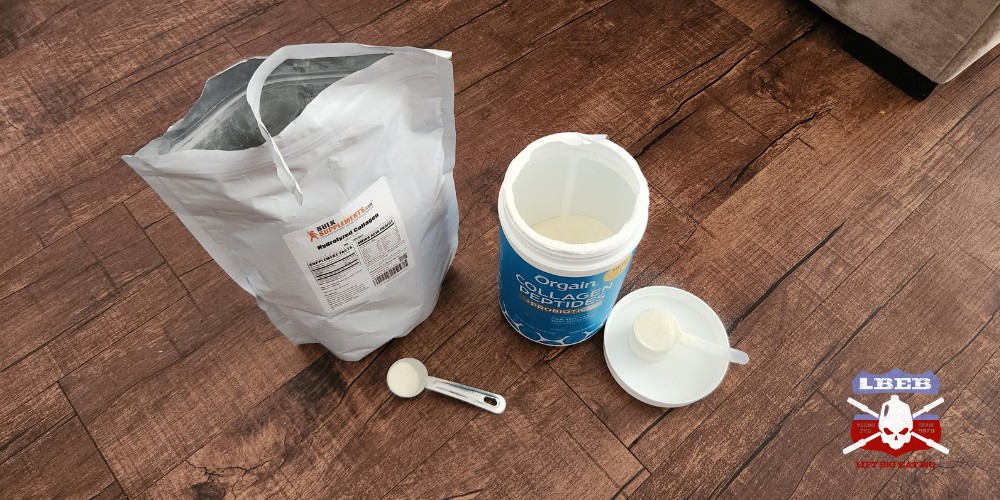Have you ever heard that jelly could have similar benefits to collagen? Technically, jelly is made of gelatin and can have similar benefits to collagen. Don’t get too excited—the amount of gelatin in a serving of jelly is not nearly enough to bring about these benefits. This brings us to the question—what is the difference between collagen and gelatin?
Collagen and gelatin have similar amino acids and will yield the same benefits, like increased tendon strength. However, collagen seems to win in taste and ease of use, while gelatin can be cheaper.
To understand which of the two will best suit you, let’s look at the difference between the two and what you need to consider before buying a collagen or gelatin supplement.
Table of Contents
What Is Collagen?
Collagen is a vital protein in the body that provides tissues with flexibility and structure. It helps muscles transfer force to tendons and bones, ensuring smooth movement and support. Collagen is dynamic and adapts to various conditions [1, 2].
Tendons, which connect muscles to bones, heavily rely on collagen, contributing significantly to their weight. Collagen’s unique structure, fuelled by amino acids like glycine and proline, gives it strength.
This strength is crucial for tendons to withstand stresses during activities like sports, promoting tendon health and reducing the risk of injuries.
In summary, collagen is not just a protein but an essential element in maintaining the body’s structural integrity.
Collagen mainly consists of three amino acids: glycine, proline, and hydroxyproline. These amino acids form a unique triple helix structure, providing collagen with strength and stability [3].
What Is Gelatin?
Gelatin is a substance made from collagen. To make gelatin, these tissues are boiled in water to extract the collagen [4, 5].
After concentrating and cooling the solution, it turns into a solid gel. Gelatin is used in many foods, such as desserts, candies, and jelly, to thicken and stabilize them.
It’s also used in pharmaceuticals, cosmetics, and the photography industry because it can gel. Gelatin is prized for its ability to add texture, stability, and structure to various products.
Collagen vs. Gelatin Main Differences

Both collagen and gelatin come from animal connective tissues, particularly collagen-rich parts like bones, skin, and cartilage.
They are derived from the same amino acids (glycine, proline, and hydroxyproline), providing tissue strength and elasticity [1, 5].
Function
In research, gelatin was used instead of collagen to study the effect of collagen on outcomes like muscle building, tendon health, and sports injuries, with comparable positive effects to collagen due to the similar amino acid composition [6, 7].
However, researchers and athletes often prefer collagen peptides over gelatin, mainly because collagen powder is easier to mix into a pre-training drink and tastes better.
How It’s Made
Collagen is found in its natural, unprocessed state within animal tissues. It serves as the structural framework that gives tissues strength and elasticity.
In contrast, gelatin results from a cooking process applied to collagen-rich tissues. During this process, collagen undergoes denaturation, breaking its fibrous structure into gelatin.
Structure
Collagen naturally forms a strong triple helix structure, supporting tissues like skin, bones, and tendons. Amino acids like glycine, proline, and hydroxyproline hold this structure together.
Using enzymes, collagen can also be broken down further into small peptides, which are smaller chains of the protein. Check out this article for a deep dive into the difference between collagen and collagen peptides.
Until exposed to heat or chemicals, collagen’s triple helix remains unchanged, keeping its strength. However, when collagen is heated, it breaks down into smaller pieces, losing its organized structure and forming gelatin.
Gelatin doesn’t have the same orderly arrangement as collagen; it’s more like a jumbled coil. This allows gelatin to dissolve easily in water.
When the dissolved gelatin cools, it turns into a gel-like substance. This unique property makes gelatin useful for thickening, stabilizing, and gelling in various foods.
Collagen stays fibrous and gives tissues support. Gelatin changes its structure and can form a jelly when mixed with water and cooled down.
This makes gelatin useful in cooking for thickening and making things stable.
Is Collagen Or Gelatin Better?
Collagen and gelatin come from animal connective tissues and offer similar benefits due to their shared amino acid composition, including glycine, proline, and hydroxyproline, which provide tissue strength and elasticity.
If you are on a budget and can stomach the gel-like structure of gelatin, go for it. But if you prefer to have a powder that can mix well with a pre-workout shake or smoothie, it is best to opt for collagen powder vs gelatin, although it can be a pricier option.
References
- Liu, D., et al., Collagen and gelatin. Annu Rev Food Sci Technol, 2015. 6: p. 527-57.
- Shoulders, M.D. and R.T. Raines, Collagen structure and stability. Annu Rev Biochem, 2009. 78: p. 929-58.
- Ricard-Blum, S., The collagen family. Cold Spring Harb Perspect Biol, 2011. 3(1): p. a004978.
- Hou, P. and J. Regenstein, Optimization of Extraction Conditions for Pollock Skin Gelatin. Journal of Food Science, 2006. 69: p. C393-C398.
- Khantaphant, S. and S. Benjakul, Comparative study on the proteases from fish pyloric caeca and the use for production of gelatin hydrolysate with antioxidative activity. Comp Biochem Physiol B Biochem Mol Biol, 2008. 151(4): p. 410-9.
- Shaw, G., et al., Vitamin C-enriched gelatin supplementation before intermittent activity augments collagen synthesis. Am J Clin Nutr, 2017. 105(1): p. 136-143.
- Liu, X., et al., Bi-phasic effect of gelatin in myogenesis and skeletal muscle regeneration. Dis Model Mech, 2021. 14(12).
